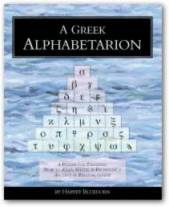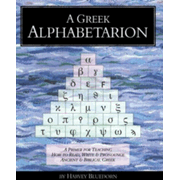A Greek Alphabetarion—a book and a companion CD—serves as an introduction to the study of Greek for all ages. The 160-page book teaches letter identification, formation, sound, and articulation, as well as relationships to the letters of our alphabet. It includes practice for blending vowels and consonants plus practice with sample reading passages.
Learners are encouraged to practice writing as they learn. A Greek Hupogrammon is a companion book you might want to purchase for this purpose. (See below.)
Charts are used to help organize the information and make it easier to learn. A set of Greek letter cards (to be copied from the book and used as flash cards) can be used for learning activities and games. Historical and linguistic background information, as well as a lesson on numerical values of the Greek letters, are also included.
The CD provides auditory input of the same information. All of these components can work together to provide multi-sensory learning for greater effectiveness. While children in the elementary grades might begin this program, it is likely to be very challenging. You might prefer to start with practice in A Greek Hupogrammon, then move into A Greek Alphabetarion.
Students junior high level and above should be able to work independently, but younger students will need varying degrees of assistance.
Continue with Trivium Pursuit's Homeschool Greek after completing this course.
A Greek Hupogrammon: A Beginner's Copybook for the Greek Alphabet with Pronunciations, also by Harvey Bluedorn, can be used on its own or as a companion to A Greek Alphabetarion.
The first half of the book works through the Greek alphabet, teaching letter formation, letter names, and pronunciation of sounds with examples and exercises Periodic review helps students retain information.
A majority of the second half of this 172-page book consists of "chrestomathy"--practice reading passages. In this case, they are all taken from Scripture. Students not only practice reading, but they also copy the passages a number of times. English translations showing the proper word order follow each phrase so students who haven't yet learned about Greek sentence structure can make sense of their translations. Following the chrestomathy is an answer key.
While the publisher suggests that students as young as ten might work independently through these lessons, I suspect that they might need some assistance, especially with pronunciations, until at least junior high.level. The publisher suggests that older students work through the Hupogrammon and Alphabetarion simultaneously since the Hupogrammon provides written practice supporting content of the Alphabetarion.
Overall, both resources are very easy to use and are very practical tools for learning Greek for homeschooling families.











